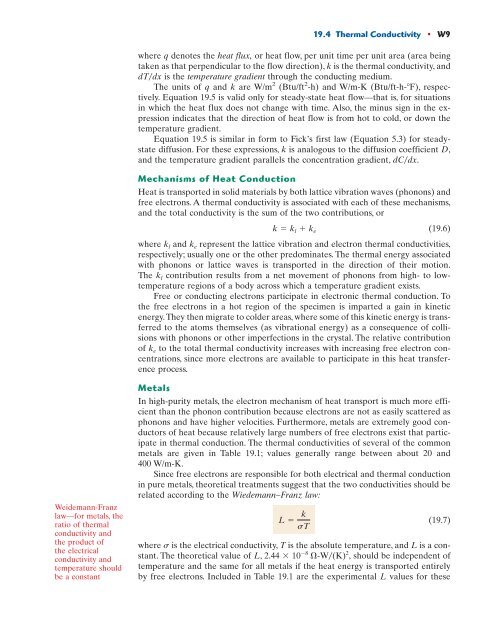Chapter 19 Thermal Properties
Chapter 19 Thermal Properties
Chapter 19 Thermal Properties
- No tags were found...
You also want an ePaper? Increase the reach of your titles
YUMPU automatically turns print PDFs into web optimized ePapers that Google loves.
<strong>19</strong>.4 <strong>Thermal</strong> Conductivity • W9where q denotes the heat flux, or heat flow, per unit time per unit area (area beingtaken as that perpendicular to the flow direction), k is the thermal conductivity, anddTdx is the temperature gradient through the conducting medium.The units of q and k are W/m 2 (Btu/ft 2 -h) and W/m-K (Btu/ft-h- F), respectively.Equation <strong>19</strong>.5 is valid only for steady-state heat flow—that is, for situationsin which the heat flux does not change with time. Also, the minus sign in the expressionindicates that the direction of heat flow is from hot to cold, or down thetemperature gradient.Equation <strong>19</strong>.5 is similar in form to Fick’s first law (Equation 5.3) for steadystatediffusion. For these expressions, k is analogous to the diffusion coefficient D,and the temperature gradient parallels the concentration gradient, dCdx.Mechanisms of Heat ConductionHeat is transported in solid materials by both lattice vibration waves (phonons) andfree electrons. A thermal conductivity is associated with each of these mechanisms,and the total conductivity is the sum of the two contributions, ork k l k e (<strong>19</strong>.6)where k l and k e represent the lattice vibration and electron thermal conductivities,respectively; usually one or the other predominates. The thermal energy associatedwith phonons or lattice waves is transported in the direction of their motion.The k l contribution results from a net movement of phonons from high- to lowtemperatureregions of a body across which a temperature gradient exists.Free or conducting electrons participate in electronic thermal conduction. Tothe free electrons in a hot region of the specimen is imparted a gain in kineticenergy.They then migrate to colder areas, where some of this kinetic energy is transferredto the atoms themselves (as vibrational energy) as a consequence of collisionswith phonons or other imperfections in the crystal. The relative contributionof k e to the total thermal conductivity increases with increasing free electron concentrations,since more electrons are available to participate in this heat transferenceprocess.Weidemann-Franzlaw—for metals, theratio of thermalconductivity andthe product ofthe electricalconductivity andtemperature shouldbe a constantMetalsIn high-purity metals, the electron mechanism of heat transport is much more efficientthan the phonon contribution because electrons are not as easily scattered asphonons and have higher velocities. Furthermore, metals are extremely good conductorsof heat because relatively large numbers of free electrons exist that participatein thermal conduction. The thermal conductivities of several of the commonmetals are given in Table <strong>19</strong>.1; values generally range between about 20 and400 W/m-K.Since free electrons are responsible for both electrical and thermal conductionin pure metals, theoretical treatments suggest that the two conductivities should berelated according to the Wiedemann–Franz law:L (<strong>19</strong>.7)where s is the electrical conductivity, T is the absolute temperature, and L is a constant.The theoretical value of L, 2.44 10 8 -W(K) 2 , should be independent oftemperature and the same for all metals if the heat energy is transported entirelyby free electrons. Included in Table <strong>19</strong>.1 are the experimental L values for theseksT












![Data Structures and Algorithms in Java[1].pdf - Fulvio Frisone](https://img.yumpu.com/30982515/1/190x245/data-structures-and-algorithms-in-java1pdf-fulvio-frisone.jpg?quality=85)
![(Microsoft PowerPoint - Topic 4.ppt [Mode de compatibilit\351])](https://img.yumpu.com/30966934/1/190x245/microsoft-powerpoint-topic-4ppt-mode-de-compatibilit351.jpg?quality=85)

